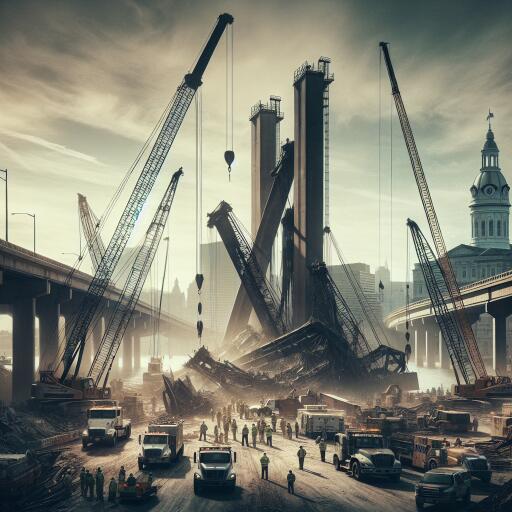Cranes Arriving to Start Removing Wreckage from Deadly Baltimore Bridge Collapse
In a critical response to the devastating collapse of the Francis Scott Key Bridge in Baltimore, cranes are being dispatched to begin the daunting task of clearing the wreckage. The largest crane on the Eastern Seaboard, capable of lifting up to 1,000 tons, is en route to the city by barge. This massive equipment, along with at least one other crane, will play a pivotal role in removing the remnants of the collapsed highway bridge and the cargo ship that collided with it earlier in the week.
Maryland Governor Wes Moore has underscored the gravity of the situation, stating that the collective efforts to clear the channel are not only about Maryland but also concern the nation’s economy. The Port of Baltimore, obstructed by the disaster, is crucial, handling more cars and more farm equipment than any other port in the United States. The governor expressed his gratitude toward the Biden administration for approving $60 million in immediate aid and reiterated that the federal government would cover the total cost of rebuilding the bridge.
With 32 members from the Army Corps of Engineers and 38 Navy contractors mobilized for the operation, the task ahead is monumental. The recent incident, resulting from a cargo ship losing power and crashing into the bridge, has left behind extensive damage and halted search efforts for four workers still missing. Through the challenging times, heroes have emerged, such as the officers from the Maryland Transportation Authority, who were recognized for their actions in preventing further loss of life by halting bridge traffic immediately after the collapse.
The management behind the cargo ship, Synergy Marine Group, has issued a statement extending sympathies to the victims’ families and assured their cooperation with ongoing investigations. Despite the hurdles, including shipping delays and the impact on the local workforce reliant on the Port of Baltimore, efforts are being made to manage the situation, including offers from neighboring states to handle disrupted cargo shipments.
The repercussions of the bridge collapse are expansive, affecting not only local commuters and dockworkers but potentially U.S. consumers due to anticipated shipping delays. The recent catastrophe has drawn attention to the vital role infrastructure plays in our daily lives and the economy at large. As cranes arrive and the recovery effort begins, the path to restoring normalcy in Baltimore and ensuring the safety and functionality of the nation’s infrastructure continues.
The Francis Scott Key Bridge, a staple in Baltimore’s landscape and history, collapsed into the Patapsco River after a cargo ship collision, leaving six presumed dead. This tragic event not only calls attention to the immediate impacts on traffic and commerce but also highlights the need for stringent safety measures and resilient infrastructure to prevent future disasters.
